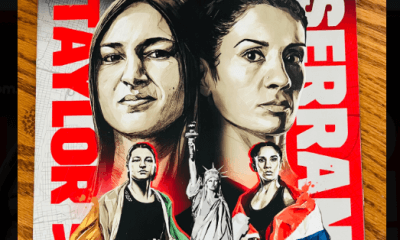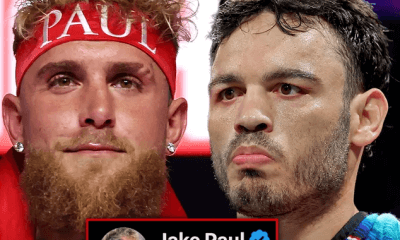Featured Articles
Lomachenko Hits the High Notes in LA Plus Undercard Results

LOS ANGELES-It was homecoming for WBO and WBA super featherweight world champion Vasyl Lomachenko and his adopted Southern California fans were eager with anticipation for his return. He did not disappoint as he crushed England’s Anthony Crolla in four rounds on Friday.
Lomachenko (13-1, 10 KOs) seemed eager to perform and like a maestro leading a symphony the Ukrainian native manipulated former world champion Crolla (34-7-3) like a violinist tuning his strings at the Staples Center. The crowd roared every movement by their conductor.
Two years had passed since his last performance in Los Angeles. That time Lomachenko was still a new commodity and a rapidly budding star. Though he has primarily trained in Oxnard, California, his last two title bouts took place in New York and Arizona. They say if you can make it in New York, well, you know the rest.
As soon as Lomachenko’s entrance music blared out White Stripes “Seven Nation Army,” the sing-a-long was on and out marched the returning hero. After one round of of the fighters adjusting to each other’s tempo, the second movement took place. From the second round on, it was all Lomachenko’s concerto. It was a strong deliberate performance with no missed notes.
Lomachenko began gauging the distance and firing four-punch combinations while looking for the return fire. Crolla was hesitant to counter.
The third round saw Lomachenko increase the tempo and fire combinations with impunity, as if daring Crolla to keep up. He could not and Lomachenko unraveled two dozen blows with deadly impact. The British mustached fighter was caught along the ropes during a Lomachenko barrage and referee Jack Reiss stepped in to halt the barrage. Lomachenko dashed to a corner believing it was a knockout. He was incorrect. The referee had merely ruled it a knockdown because of Crolla’s use of the ropes to stay erect. The fight proceeded and seconds later the bell rang ending it. Crolla had survived.
Lomachenko had a look of quiet anger in his eyes as he waited for the fourth round to begin. As soon as the bell rang the Ukrainian southpaw went into attack mode and Crolla seemed determined to survive. As Lomachenko herded the Englishman to the ropes he fired a left cross then a quick right hook on top of Crolla’s left ear. Down he went as if shot with a bullet, face first. Crolla could not move and referee Reiss signaled the fight over at 58 seconds of round four.
The crowd erupted.
When asked who should be his next foe Lomachenko was ready for a quick reply.
“I want to fight Mikey Garcia but we’ll see, I don’t know,” said Lomachenko. “I want to unify all the titles.”
After Lomachenko’s quick interview the crowd quickly dispersed into the night. The crescendo had been reached. The boxing fans in Los Angeles have found a new maestro to follow and it’s clear Lomachenko no longer needs to travel to other destinations. Southern California has adopted him. He is a winner..
Zurdo
Super middleweight titlist Gilberto “Zurdo” Ramirez (40-0,26 KOs) moved up in weight and found it agreeable as he won by technical knockout over former light heavyweight world title challenger Tommy Karpency (29-7-1, 18 KOs).
Ramirez, a southpaw, was matched with another southpaw and the two took their time trading body shots. In the second round Ramirez began connecting with right hooks and soon had Karpency backing up a bit.
The fourth round saw a right hook stun Karpency and Ramirez followed up with four-punch combinations. A few more right hooks connected for the Mexican lefty and the end was near. After the round ended referee Ray Corona signaled the fight was over at the end of the fourth round.
“I feel a lot of power,” said Ramirez about fighting at a heavier 175 pounds instead of 168.
Is his stay at 168 pounds over for good?
Other bouts
South El Monte’s Arnold Barboza (21-0, 8 KOs) knocked out former world champion Mike Alvarado (40-5, 28 KOs) in their super lightweight title fight. A right uppercut followed by a right cross floored Alvarado who went down hard. He struggled to get up twice and staggered into referee Tom Taylor’s arms who immediately signaled the fight over at 49 seconds of round three. Barboza keeps the NABF junior title.
“The uppercut is my favorite punch. I worked on it all through camp with my dad,” said Barboza. “We were ready for his overhand right.”
Barboza said he wants a crack at WBC titlist Jose Carlos Ramirez or WBO Maurice Hooker. “Either one,” he said.
Kazakhstan’s Janibek Alimkhanuly (6-0, 2 KOs) had an easy 10 round decision win over San Diego’s Cristian Olivas (16-5, 13 KOs). Alimkhanuly used a jab and short combinations from a southpaw stance to cruise to victory in a middleweight fight. Scores were 100-90 twice and 99-91 for Alimkhanuly.
Alexander Besputin (13-0, 9 KOs) nearly swept every round in winning by unanimous decision over Argentina’s Alfredo Blanco (20-8, 11KOs) after a 10 round welterweight fight for the USBA title. Besputin fights out of Oxnard. Scores were 100-90 twice and 99-91for Besputin.
Italian heavyweight Guido Vianello (3-0, 3 KOs) needed only 49 seconds to knock out Lawrence Gabriel (3-2-1). Vianello fired a counter right cross that staggered Gabriel and then four more blows finished him. Referee Tom Taylor called the fight.
Ruben Rodriguez (6-0, 2 KOs) out-punched Ramel Snegur (3-4-1) nearly every round but won by majority decision after four rounds in a welterweight contest. Rodriguez fights out of Indio, California.
Photo credit: Al Applerose
Check out more boxing news on video at The Boxing Channel
To comment on this story in The Fight Forum CLICK HERE
-

 Featured Articles4 weeks ago
Featured Articles4 weeks agoAvila Perspective, Chap. 330: Matchroom in New York plus the Latest on Canelo-Crawford
-

 Featured Articles3 weeks ago
Featured Articles3 weeks agoVito Mielnicki Jr Whitewashes Kamil Gardzielik Before the Home Folks in Newark
-

 Featured Articles21 hours ago
Featured Articles21 hours agoResults and Recaps from New York Where Taylor Edged Serrano Once Again
-

 Featured Articles4 weeks ago
Featured Articles4 weeks agoCatching Up with Clay Moyle Who Talks About His Massive Collection of Boxing Books
-

 Featured Articles5 days ago
Featured Articles5 days agoFrom a Sympathetic Figure to a Pariah: The Travails of Julio Cesar Chavez Jr
-

 Featured Articles3 weeks ago
Featured Articles3 weeks agoMore Medals for Hawaii’s Patricio Family at the USA Boxing Summer Festival
-

 Featured Articles1 week ago
Featured Articles1 week agoCatterall vs Eubank Ends Prematurely; Catterall Wins a Technical Decision
-

 Featured Articles4 weeks ago
Featured Articles4 weeks agoRichardson Hitchins Batters and Stops George Kambosos at Madison Square Garden




















